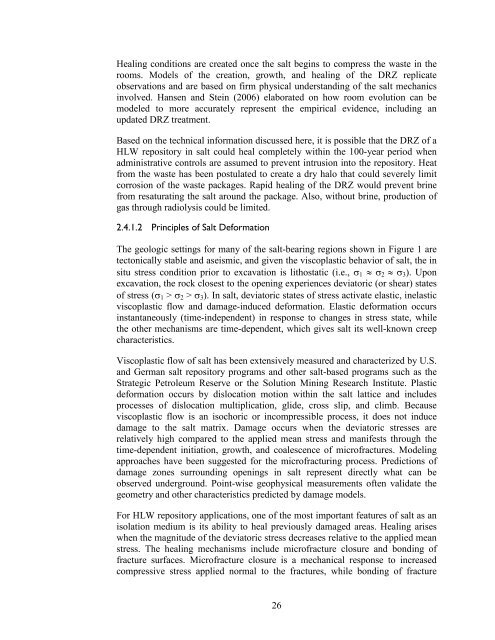Salt Disposal of Heat-Generating Nuclear Waste
Salt Disposal of Heat-Generating Nuclear Waste
Salt Disposal of Heat-Generating Nuclear Waste
Create successful ePaper yourself
Turn your PDF publications into a flip-book with our unique Google optimized e-Paper software.
Healing conditions are created once the salt begins to compress the waste in the<br />
rooms. Models <strong>of</strong> the creation, growth, and healing <strong>of</strong> the DRZ replicate<br />
observations and are based on firm physical understanding <strong>of</strong> the salt mechanics<br />
involved. Hansen and Stein (2006) elaborated on how room evolution can be<br />
modeled to more accurately represent the empirical evidence, including an<br />
updated DRZ treatment.<br />
Based on the technical information discussed here, it is possible that the DRZ <strong>of</strong> a<br />
HLW repository in salt could heal completely within the 100-year period when<br />
administrative controls are assumed to prevent intrusion into the repository. <strong>Heat</strong><br />
from the waste has been postulated to create a dry halo that could severely limit<br />
corrosion <strong>of</strong> the waste packages. Rapid healing <strong>of</strong> the DRZ would prevent brine<br />
from resaturating the salt around the package. Also, without brine, production <strong>of</strong><br />
gas through radiolysis could be limited.<br />
2.4.1.2 Principles <strong>of</strong> <strong>Salt</strong> Deformation<br />
The geologic settings for many <strong>of</strong> the salt-bearing regions shown in Figure 1 are<br />
tectonically stable and aseismic, and given the viscoplastic behavior <strong>of</strong> salt, the in<br />
situ stress condition prior to excavation is lithostatic (i.e., σ 1 ≈ σ 2 ≈ σ 3 ). Upon<br />
excavation, the rock closest to the opening experiences deviatoric (or shear) states<br />
<strong>of</strong> stress (σ 1 > σ 2 > σ 3 ). In salt, deviatoric states <strong>of</strong> stress activate elastic, inelastic<br />
viscoplastic flow and damage-induced deformation. Elastic deformation occurs<br />
instantaneously (time-independent) in response to changes in stress state, while<br />
the other mechanisms are time-dependent, which gives salt its well-known creep<br />
characteristics.<br />
Viscoplastic flow <strong>of</strong> salt has been extensively measured and characterized by U.S.<br />
and German salt repository programs and other salt-based programs such as the<br />
Strategic Petroleum Reserve or the Solution Mining Research Institute. Plastic<br />
deformation occurs by dislocation motion within the salt lattice and includes<br />
processes <strong>of</strong> dislocation multiplication, glide, cross slip, and climb. Because<br />
viscoplastic flow is an isochoric or incompressible process, it does not induce<br />
damage to the salt matrix. Damage occurs when the deviatoric stresses are<br />
relatively high compared to the applied mean stress and manifests through the<br />
time-dependent initiation, growth, and coalescence <strong>of</strong> micr<strong>of</strong>ractures. Modeling<br />
approaches have been suggested for the micr<strong>of</strong>racturing process. Predictions <strong>of</strong><br />
damage zones surrounding openings in salt represent directly what can be<br />
observed underground. Point-wise geophysical measurements <strong>of</strong>ten validate the<br />
geometry and other characteristics predicted by damage models.<br />
For HLW repository applications, one <strong>of</strong> the most important features <strong>of</strong> salt as an<br />
isolation medium is its ability to heal previously damaged areas. Healing arises<br />
when the magnitude <strong>of</strong> the deviatoric stress decreases relative to the applied mean<br />
stress. The healing mechanisms include micr<strong>of</strong>racture closure and bonding <strong>of</strong><br />
fracture surfaces. Micr<strong>of</strong>racture closure is a mechanical response to increased<br />
compressive stress applied normal to the fractures, while bonding <strong>of</strong> fracture<br />
26
















